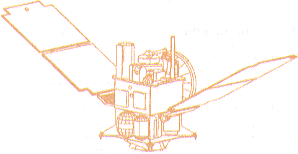

Live From Mars was active July 1996-December 1997.
Today on Mars
We anticipate carriage by participating PBS stations and NASA-TV: Check your local listings! For the first time, Closed Captioning will be made available thanks to additional support from the Digital Equipment Corporation.
| Today on Mars will truly be "live from Mars," featuring real-time imagery returning from the Red Planet. The Pathfinder lander completes its primary mission in 30 Earth days, but planners hope it will continue to operate for some time after that, perhaps on through 1998. Sojourner's baseline mission is for seven days--but again, there's hope the plucky, little rover will keep going and going and going. Meanwhile, Mars Global Surveyor should be in orbit and in all likelihood will have returned at least some "contingency science," new high-resolution images and data, even while it is adjusting its orbit down to its final, planned configuration. |  |
"Today on Mars" will be a kind of "weathercast" for the Red Planet, an update on the temperature, winds and other information gathered from the missions. Has Mars in fact dropped 20 degrees since Viking landed, as Hubble Space Telescope data seem to indicate? What have the travels of Sojourner shown us, both about Mars itself, and about the capabilities of small exploratory rovers? What has Alpa Proton X-ray Spectrometer told us about the actual composition of the rocks? What can Mars Global Surveyor see from orbit with its powerful cameras?
Mission scientists, some of whom students will have met almost one year earlier, will comment on the highs and lows of the journey to Mars, what they've learned about Mars, about high-risk, high-reward life on the scientific frontier, and what they hope will happen next. We'll see how the simulated Martian landscape at JPL has evolved since we saw it last in April 1997: the scientists will now have created a model of the actual landing site where Pathfinder sits on Mars. The technicians and engineers will be assessing Pathfinder's and Sojourner's strengths and weaknesses as they continue to build and test the next generation of landers and rovers.
The program will also feature on-camera student demonstrations about how to use the Internet to access and analyze the wealth of new data that are coming back, so that participating schools can literally get their hands on the same raw numbers with which the scientists are also working. MGS scientists will show how the spacecraft is able to characterize the Martian surface from orbit.
This is the final video currently planned as part of Live From Mars. But just as with Pathfinder, circumstance may permit an "extended mission." Additional programming may follow, most likely via NASA-TV. Indeed, in fall '97, Surveyor's primary mission is just beginning, with its main data collection slated for early 1998 and on throughout that year. And our other component, the Internet, will provide ways to follow MGS's mission on through 1998--at which time NASA's next two Mars missions should be ready to launch!
The process of scientific inquiry is open-ended; what we learn from the MPF and MGS missions will only lead to greater challenges in the continuing exploration of our solar system and beyond. Similarly, this Live From Mars electronic field trip module is open-ended. It is intended to be used again, in whole or in part, with multiple school groups in the coming years. Reuse of the print and video components along with online access will allow students and teachers to continue their learning "mission" right alongside the Mars scientists. Real Science at Real Locations with Real Scientists in Real Time!

![]()